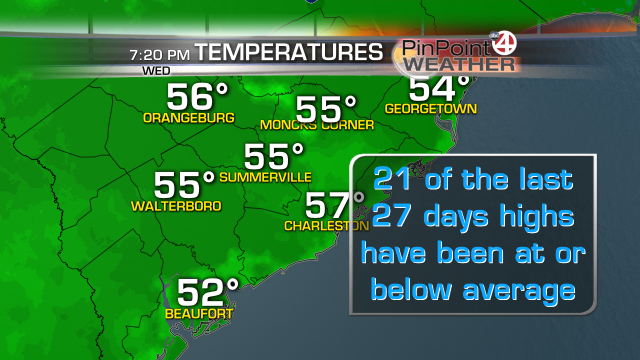Warning: I know very little about probability. I know even less about weather phenomena! The post below describes something I was thinking about today, because I find it interesting and I’m procrastinating when I should be grading a giant pile of calculus exams instead!
The following image appeared on my Twitter feed, courtesy of @LCWxDave:
This made me wonder, “What is the probability that at least 21 of the last 27 day’s highs have been at or below average?”
First, let’s make two (probably bad) assumptions: (1) High temperatures are normally distributed, and (2) the events “Today’s high temp” and “tomorrow’s high temp” are independent. If this is the case, then the probability requested above is
(27!/(21!6!)+27!/(22!5!)+27!/(23!4!)+27!/(24!3!)+27!/(25!2!)+27!/(26!1!)+27!/27!)*(0.5^(27)) = 0.0029623
or about three-tenths of one percent. This struck me as being exceedingly rare! Then Dan Jarratt pointed out,
8% of years since 1893 have had 21+ days of March 1-27 with max temps below average. Data @ Utah Climate Center
— Dan Jarratt (@danjarratt) March 28, 2013
It puzzled me that my computed probability was 0.3% but the actual collected data suggest happened 8% of the time! What’s going on?
First, I still have no idea about my assumption about temperatures and normal distributions. Second, I really ought to do a more careful calculation and not treat each day’s high temperature as independent from the next day’s high. Surely, if it’s very cold on Wednesday, it is probably pretty likely it’s going to be cold on Thursday, too.
So instead of treating the 27 days as 27 different events, let’s consider them as 13 two-day events. Out of these 13 two-day events, about 10 of the two-day events have been colder than average. New question: “What is the probability that at least 10 of the last 13 two-day’s highs have been at or below average?”
In this case, the computation yields
(13!/(10!3!)+13!/(11!2!)+13!/(12!1!)+13!/(13!))*(0.5)^(13) = 0.046142578125
So my computed probability is 4.6% with the data suggesting 8%. The comparison between these two seems far more reasonable. What this tells me is that today’s weather seems quite dependent on yesterday’s weather, which isn’t surprising. After discussing this with my colleague Garrett Mitchener, he pointed out that a great way to predict tomorrow’s weather is to say that it will be exactly like today. Hopefully, we are better mathematicians than weather predictors.


I recall a simple example of Markov chains applied to weather, with a 2×2 matrix. Something like: If it is a sunny day, the chance that tomorrow is sunny again is 0.8; 0.2 for rainy day. But if it is a rainy day, the chance that the next day is rainy again is 0.45 (0.55 for a sunny one). Then, the transition matrix is
0.8 0.45
0.2 0.55
and you can predict, with an initial value, the weather in n days by multiplying the matrix n times.
that’s it 🙂